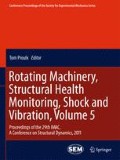Abstract
The presence of a crack in repeating structures, like gas turbine blade sets, causes local variation in the stiffness that affects the overall mechanical behaviour of the system. Crack characterization is essential to understand the effects on the dynamic response of the whole system. This paper introduces an approach for amplitude dependent crack characterisation considering fatigue crack growth. A test rig is established and a dog-bone type specimen is considered for this experimental work. Cracks are introduced into the specimen through fatigue loads at resonant frequencies. The dynamics of the cracked specimen are obtained by measuring the frequency response functions (FRFs). Different vibration amplitude settings are considered to investigate the nonlinear behaviour of breathing cracks on the FRFs. Natural frequency and modal damping ratios are measured for flexural and torsional vibration modes; these exercise the cracks in different directions. A comparison of output responses is made between crack-free and cracked specimens. Test samples are fatigued and tested repeatedly to analyze the cracks of various depths. Experimental results are then compared with FE simulations.
Access this chapter
Tax calculation will be finalised at checkout
Purchases are for personal use only
Preview
Unable to display preview. Download preview PDF.
References
Salawu, O.S., Detection of structural damage through changes in frequency: a review, Engineering Structures, Vol. 19, No. 9, pp. 718-723, 1997.
Rehman, A.U., Rongong, J. A. and Worden, K., Detection of Damage in Repeating Structures, Proceedings of the ASME Turbo Expo 2010: Power for Land, Sea and Air, GT 2010, June 14-18, 2010, Glasgow, UK.
Slastan, J., and Pietrzko, S., Changes of RC-beam modal parameters due to cracks. In: (1st edn.), Proceedings, 11h International Modal Analysis Conference, Kissimmee, Florida 1 (1993), pp. 70–76.
Begg, R. D., Mackenzie, A.C., Dodds, C.J. and Loland, O., Structural integrity monitoring using digital processing of vibration signals. In: (1st edn), Proceedings, 8th Offshore Technology Conference, Houston, Texas 2 (1994).
Salawu, O.S., Identification of damage-sensitive vibration modes. In: Vibration and Noise '95, Proceedings of the International Conference on Vibration and Noise (April 25–27 1995).
Cheong, Young-Moo, Alam, M. K. and Kim, CheolGi, Nonlinear parameters for a diagnosis of micro-scale cracks using a nonlinear resonant ultrasound spectroscopy (NRUS), Review of quantitative non-destructive evaluation Vol. 29, 2010 American institute of physics 978-0-7354-0/10.
Meo, M., Ploimeno, U. and Zumpano, G., Detecting damage in composite material using nonlinear elastic wave spectroscopy methods, Appl compos mater (2008) 15:115-126, DOI 10.1007/s10443-008-9061-7.
Muller, M., Sutin, A., Guyer, R. and Johnson, P.A., Nonlinear resonant ultrasound spectroscopy (NRUS) applied to damage assessment in bone, J. Acoust. Soc. Am. 118 (6), 2005.
Pany, C. and Rao, G. V., Calculation of nonlinear fundamental frequency of a cantilever beam using nonlinear stiffness, Journal of sound and vibration (2002) 256(4), 787-790.
Johnson, P. A., The New Wave in Acoustic Testing, Materials World, The J. Inst. Materials, 7, pp. 544 –546 (1999).
Abeele, V., Carmeliet, J. and Johnson, P. A., Nonlinear Elastic Wave Spectroscopy (NEWS) Techniques to Discern Material Damage, Part II: Single-Mode Nonlinear Resonance Acoustic Spectroscopy, Research in Nondestructive Evaluation, 12, pp. 31– 42 (2000).
Friswell, M. I., Penny, J. E. T.Crack Modeling for Structural Health Monitoring Journal of Structural Health Monitoring (SHM) Vol 1(2): 0139-148 [1475-9217 (200210) 1:2; 139-148; 10.1106/145792102028836].
Papatheou, E., Manson, G., Barthorpe, R. J., Worden, K., The use of pseudo-faults for novelty detection in SHM, Journal of Sound and Vibration, Volume 329, Issue 12, 7 June 2010, Pages 2349-2366.
Author information
Authors and Affiliations
Editor information
Editors and Affiliations
Rights and permissions
Copyright information
© 2011 Springer Science+Business Media, LLC
About this paper
Cite this paper
Rehman, A.U., Worden, K., Rongong, J.A. (2011). Amplitude Dependent Crack Characterization of Growing Fatigue Cracks. In: Proulx, T. (eds) Rotating Machinery, Structural Health Monitoring, Shock and Vibration, Volume 5. Conference Proceedings of the Society for Experimental Mechanics Series. Springer, New York, NY. https://doi.org/10.1007/978-1-4419-9428-8_7
Download citation
DOI: https://doi.org/10.1007/978-1-4419-9428-8_7
Published:
Publisher Name: Springer, New York, NY
Print ISBN: 978-1-4419-9427-1
Online ISBN: 978-1-4419-9428-8
eBook Packages: EngineeringEngineering (R0)

